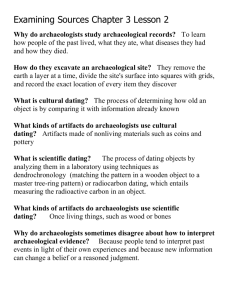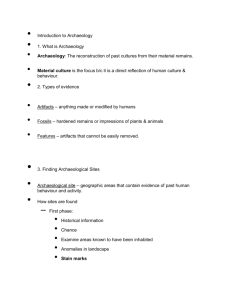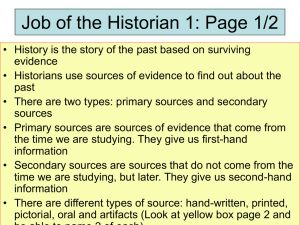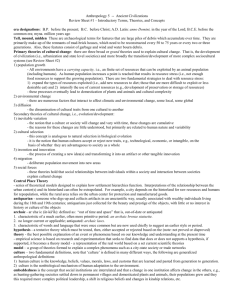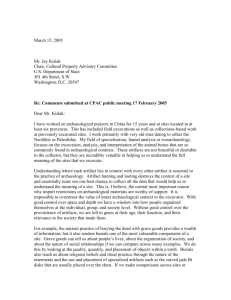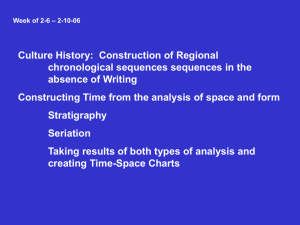RS1 Arch terms and theories
advertisement
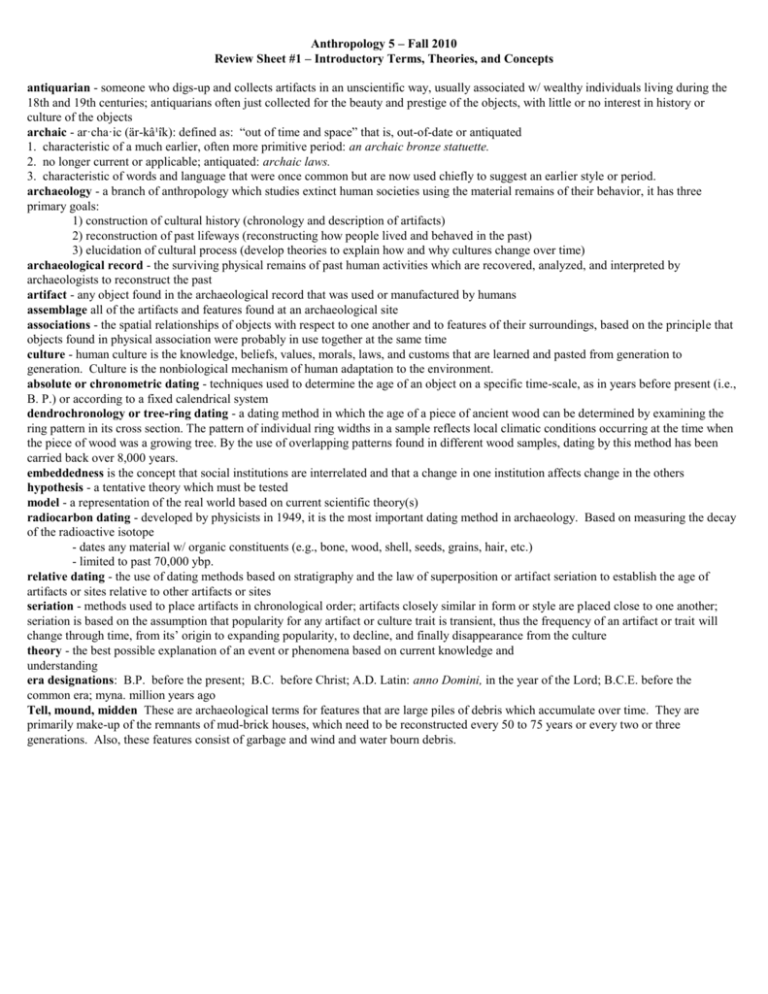
Anthropology 5 – Fall 2010 Review Sheet #1 – Introductory Terms, Theories, and Concepts antiquarian - someone who digs-up and collects artifacts in an unscientific way, usually associated w/ wealthy individuals living during the 18th and 19th centuries; antiquarians often just collected for the beauty and prestige of the objects, with little or no interest in history or culture of the objects archaic - ar·cha·ic (är-kâ¹îk): defined as: “out of time and space” that is, out-of-date or antiquated 1. characteristic of a much earlier, often more primitive period: an archaic bronze statuette. 2. no longer current or applicable; antiquated: archaic laws. 3. characteristic of words and language that were once common but are now used chiefly to suggest an earlier style or period. archaeology - a branch of anthropology which studies extinct human societies using the material remains of their behavior, it has three primary goals: 1) construction of cultural history (chronology and description of artifacts) 2) reconstruction of past lifeways (reconstructing how people lived and behaved in the past) 3) elucidation of cultural process (develop theories to explain how and why cultures change over time) archaeological record - the surviving physical remains of past human activities which are recovered, analyzed, and interpreted by archaeologists to reconstruct the past artifact - any object found in the archaeological record that was used or manufactured by humans assemblage all of the artifacts and features found at an archaeological site associations - the spatial relationships of objects with respect to one another and to features of their surroundings, based on the principle that objects found in physical association were probably in use together at the same time culture - human culture is the knowledge, beliefs, values, morals, laws, and customs that are learned and pasted from generation to generation. Culture is the nonbiological mechanism of human adaptation to the environment. absolute or chronometric dating - techniques used to determine the age of an object on a specific time-scale, as in years before present (i.e., B. P.) or according to a fixed calendrical system dendrochronology or tree-ring dating - a dating method in which the age of a piece of ancient wood can be determined by examining the ring pattern in its cross section. The pattern of individual ring widths in a sample reflects local climatic conditions occurring at the time when the piece of wood was a growing tree. By the use of overlapping patterns found in different wood samples, dating by this method has been carried back over 8,000 years. embeddedness is the concept that social institutions are interrelated and that a change in one institution affects change in the others hypothesis - a tentative theory which must be tested model - a representation of the real world based on current scientific theory(s) radiocarbon dating - developed by physicists in 1949, it is the most important dating method in archaeology. Based on measuring the decay of the radioactive isotope - dates any material w/ organic constituents (e.g., bone, wood, shell, seeds, grains, hair, etc.) - limited to past 70,000 ybp. relative dating - the use of dating methods based on stratigraphy and the law of superposition or artifact seriation to establish the age of artifacts or sites relative to other artifacts or sites seriation - methods used to place artifacts in chronological order; artifacts closely similar in form or style are placed close to one another; seriation is based on the assumption that popularity for any artifact or culture trait is transient, thus the frequency of an artifact or trait will change through time, from its’ origin to expanding popularity, to decline, and finally disappearance from the culture theory - the best possible explanation of an event or phenomena based on current knowledge and understanding era designations: B.P. before the present; B.C. before Christ; A.D. Latin: anno Domini, in the year of the Lord; B.C.E. before the common era; myna. million years ago Tell, mound, midden These are archaeological terms for features that are large piles of debris which accumulate over time. They are primarily make-up of the remnants of mud-brick houses, which need to be reconstructed every 50 to 75 years or every two or three generations. Also, these features consist of garbage and wind and water bourn debris. Primary theories of cultural change: there are three broad or grand theories used to explain cultural change. That is, the development of civilization (i.e., urbanization and state level societies) and more broadly the transition/development of more complex sociocultural systems (see Review Sheet #2) 1) population growth - All environments have a carrying capacity, i.e., an finite set of resources that can be exploited by an animal population (including humans). As human population increases a point is reached that results in resource stress (i.e., not enough food resources to support the growing population). There are two fundamental strategies to deal with resource stress: 1) expand the types of resources exploited (i.e., add new resources to diet; those that are more difficult to exploit or less desirable eat) and 2) intensify the use of current resources (e.g., development of preservation or storage of resources) - these processes eventually lead to domestication of plants and animals and cultural complexity 2) environmental change - there are numerous factors that interact to affect climatic and environmental change, some local, some global 3) diffusion - the dissemination of cultural traits from one cultural to another Secondary theories of cultural change, i.e., evolution/development: 1) inevitable variation - the notion that a culture or society will change and vary with time, these changes are cumulative - the reasons for these changes are little understood, but primarily are related to human nature and variability 2) cultural selection - this concept is analogous to natural selection in biological evolution - it is the notion that human cultures accept or reject new traits, e.g., technological, economic, or intangible, on the basis of whether they are advantageous to society as a whole 3) invention and innovation - the process of creating a new idea(s) and transforming it into an artifact or other tangible innovation 4) migration - deliberate population movement into new areas 5) social forces - these theories hold that social relationships between individuals within a society and interaction between societies explain cultural change Central Place Theory - series of theoretical models designed to explain how settlement hierarchies function. Interpretations of the relationship between the urban center(s) and its hinterland can often be extrapolated. For example, a city depends on the hinterland for raw resources and humans for repopulation, while the rural area relies on the urban center for protection and manufactured goods. hypothesis - a tentative theory which must be tested, then, either accepted or rejected based on the (note: not proved or disproved) theory - the best possible explanation of an event or phenomena based on our knowledge and understanding at the present time - empirical science is based on research and experimentation that seeks to find data that does or does not supports a hypothesis, if supported, it becomes a theory model - a representation of the real world based on a set current scientific theories model – a group of theories formed to explain a complex phenomena such as a city-state society or trade networks culture – two fundamental definitions, note that ‘culture’ is defined in many different ways, the following are generalized anthropological definitions: 1) human culture is the knowledge, beliefs, values, morals, laws, and customs that are learned and pasted from generation to generation. 2) culture is the nonbiological mechanism of human adaptation to the environment. embeddedness is the concept that social institutions are interrelated and that a change in one institution affects change in the others, e.g., as hunting-gathering societies settled down in permanent villages and domesticated plants and animals, their populations grew and they this required more complex political leadership, a shift in religious beliefs and changes in kinship relations, etc. Research of the ancient, i.e., how we know about the ancient world - there are numerous methods use by archaeologists and historians learn about the ancient world: 1) archaeological excavations 2) historical record, e.g.: - clay tablets burnt in building fires - papyrus (pl. papyri) documents, e.g.: - Dead Sea Scrolls found in caves in Israel - Oxyrhynchus, Egypt – an administrative center established by the Greeks - 400,000 Greek and Roman documents of manuscript fragments found in city’s dump, covering a 1000 year period, including invioices, administrative and military correspondences, tax records, licenses, students’ jottings, and literary works - because papyrus was expensive it was reused, infrared imaging has allowed reading of material written over and on the back of other documents, technique has lead to a 20% increase in literary works metallurgy – the process of separating metals from their ores - the processes employed depend upon the chemical nature of the ore to be treated and upon the properties of the metal to be extracted. - when an ore has a low percentage of the desired metal, a method of physical concentration must be used before the extraction process begins. - because almost all metals are found combined with other elements in nature, chemical reactions are required to set them free - these chemical processes include smelting or the use of heat for the treatment of an ore and leaching, the selective dissolution of metals from their ores. - principal metals used were copper, gold, silver, lead, and tin - the use of metal ore involves: 1) mining of metals 2) annealing (i.e., gradual heating followed by gradual cooling to reduce brittleness and enhance toughness 3) alloying (i.e., mixing two or more metal to make a new one), makes metal easier to cast, harder and more durable 4) extraction or smelting of metal from crystalline ores - two necessary conditions: a) heat in excess of 1000-1200 degrees; b) reduce oxygen atmosphere 5) production methods: a) cold hammering, 2) heating and hammering, and 3) melting and casting - metallurgy was invented independently in China, Western Asia, Egypt, and Europe copper – first worked by cold hammer method c. 6000 B. P. bronze is an alloy of cooper and tin in 1:7 to 1:10 ration (occasionally arsenic) - the first manufacture of bronze items (primarily weapons and simple tools) occurred in Mesopotamia ca. 5500 B.P.. While in China bronze was developed ca. 4200 B.P., primarily for ritual items related to ancestor worship and divination , during the Longshan Phase. - innovation improved agriculture production, increased long distance trade, allowed for construction of monumental architecture - metallurgy independently invented in middle east, Balkans, Spain, North America, and China - innovation improved agriculture production, increased long distance trade, allowed for construction of monumental architecture



